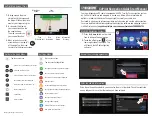
interest feature you don’t need to wander around hoping you’ll find
something.
As I mentioned, the GPS system uses a bunch of satellites that orbit above the Earth to
help your GPS receiver find its exact position. The satellites are over 12,000 miles
(20,000 km) above the surface of the planet and at least four of them are always
somewhere above you (usually there are a lot more, but your receiver needs to get
signals from at least four of them to correctly determine where you are). By the way, the
radio signals from those satellites aren’t very strong so in most cases a GPS receiver
won’t work inside a building, at the bottom of a deep hole, or even if you’re surrounded
by a dense forest (or skyscrapers).
Getting Used to Your GPS Navigation Device
Navigation using the GPS is really pretty easy, but it can take a little bit of getting used
to. With a GPS navigation device you start by telling the receiver where you want to go.
In most cases you do so by specifying an address, by choosing from a list of points of
interest, or by choosing a saved place that you’ve saved earlier. Because the GPS
navigation device already knows where you are by listening for those satellite signals, it
then maps out a route from your current location to your destination.
Note:
Most GPS navigation devices allow you to choose the type of route you want to
follow. GPS navigation devices that are designed for automobile navigation—such as
those from Pharos—usually pick the fastest route unless you choose a different option.
You might also find options such as the shortest route, one that avoids highways, or one
that avoids toll roads.
When you navigate using a GPS navigation device, your current position is shown on a
map on the display using an arrow to indicate your direction. Depending on how much
close-up detail or overall idea of the route you want to see, you can zoom in or zoom
out on the map (the zooming method can be different for different GPS navigation
device models, but it’s always pretty easy). I generally find that zooming in is very
helpful—especially when I have to make turns in an unfamiliar area.
The Pharos GPS navigation devices provide a couple of handy options (which you’ll
find on the Options menu) for how you’d like the map to appear. You can choose the
one that you like the best because whatever you choose won’t have any effect on how
the GPS navigation device works:
•
Smart Heading up
makes the map rotate automatically as you drive so that
the direction of your route is always towards the top of the display. This
































